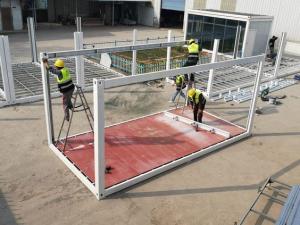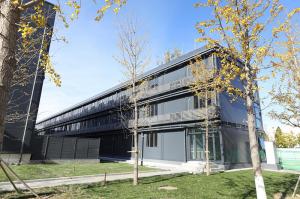CSCEC's Homagic Achieves Breakthrough in Zero-Carbon Modular Construction with China's First MiC Project
SHENZHEN, GUANGDONG, CHINA, November 9, 2025 /EINPresswire.com/ -- In a landmark achievement for sustainable building, Homagic, the modular construction arm of China State Construction Engineering Corporation (CSCEC), has successfully delivered China's first zero-carbon Modular integrated Construction (MiC) project. This pioneering initiative not only demonstrates the viability of carbon-neutral building at scale but also positions Homagic as a leader in the rapidly evolving prefabricated construction sector.
The modular construction industry is undergoing explosive growth, driven by global pressures for faster, greener, and more cost-effective building solutions. According to McKinsey, the modular market could reach $130 billion by 2030 in the U.S. and Europe alone, assuming moderate penetration rates. This expansion is fueled by acute labor shortages in mature economies, where skilled workers are increasingly scarce, and traditional on-site construction faces delays and cost overruns averaging 20-30%. Modular techniques address these by shifting up to 90% of work to controlled factory environments, slashing timelines by 20-50% and reducing waste significantly.
Sustainability is another key trend reshaping the sector. With governments worldwide committing to net-zero goals—China's "dual carbon" strategy targeting peak emissions by 2030 and neutrality by 2060—modular construction aligns perfectly. Factory-based production minimizes site disruption, cuts material waste by up to 90%, and enables precise integration of energy-efficient components like advanced insulation and renewables. The global push for ESG (Environmental, Social, Governance) compliance further accelerates adoption; institutional investors and regulators favor contractors with proven low-carbon credentials, reducing regulatory risks and unlocking preferential financing.
Urbanization adds urgency. By 2035, the world will need to build infrastructure equivalent to adding a city the size of Paris every week, per UN estimates. Traditional methods struggle with this scale, plagued by weather delays, supply chain volatility, and high labor costs in high-wage regions. Modular integrated Construction (MiC) counters this through Design for Manufacture and Assembly (DfMA), treating buildings like manufactured products—standardized, repeatable, and scalable. Technologies such as BIM (Building Information Modeling), ERP systems, and robotic automation enhance precision, while hybrid materials (steel-concrete composites) expand applications to high-rise and complex structures.
Market dynamics favor large-scale players with supply chain dominance. In China, state-backed giants like CSCEC leverage national policies for rapid deployment, while globally, partnerships bridge expertise gaps. The sector's B2B focus targets infrastructure, real estate, and emergency response, with permanent modular assets (50+ year lifespans) qualifying for long-term financing unlike temporary prefab. Challenges persist, including logistics for international projects and regulatory harmonization, but trends point to 20% cost savings and resilience against disruptions like pandemics or natural disasters. As labor costs rise and climate mandates tighten, modular construction is poised to capture 10-15% of new builds in developed markets by 2030, evolving from niche to mainstream.
Homagic embodies these industry shifts with unmatched core advantages rooted in CSCEC's global 500 stronghold. As CSCEC's dedicated MiC platform, Homagic benefits from the parent company's EPC expertise, vast supply chains, and R&D institute focused on intelligent manufacturing and low-carbon tech. This integration ensures financial stability, scalability, and risk mitigation that startups can't match. Homagic's "build houses like cars" philosophy via DfMA achieves 90% off-site completion, transferring risks from unpredictable sites to factory precision. Their Shenzhen facility boasts an annual capacity of 30,000 modules, equipped with robots, flexible lines, and integrated software (BIM, MES) for end-to-end lifecycle control.
Core products span versatile systems: Concrete MiC (C-MiC) for superior rigidity and acoustics in dense urban settings; Steel MiC (S-MiC) for speed and lightweight high-rises; and innovative CMC hybrid for blended strengths in fire resistance and spans. Permanent MiC lines support up to 20 stories with 50-year durability, ideal for hospitals, schools, apartments, and hotels. Light Gauge Steel (LGS) variants reach 15 stories for villas, factories, and commercial spaces. Temporary modules (1-3 stories, 10-20 years) excel in camps, rescue ops, and fire stations. All emphasize zero-carbon alignment, with factory processes slashing on-site pollution and enabling full ESG compliance.
Application scenarios highlight Homagic's efficiency. In urban renewal, C-MiC transformed Beijing's Huapi Factory Hutong No. 8 in just three months—a demolition-rebuild first in China, minimizing resident disruption. For high-density developments, S-MiC powers projects like Shenzhen Bay ICC Hotel. Emergency prowess shines in the COVID-19 response: Homagic supplied 200 modules in three days, contributing to Leishenshan Hospital's 12-day build. Advanced sewage isolation, HDPE membranes, and BIM-guided assembly ensured safety without speed compromises.
Major client cases underscore reliability. As part of CSCEC, Homagic has delivered for government megaprojects, including "One Belt One Road" initiatives. Strategic ties with CIMC-MBS amplify global reach, combining Homagic's scale with CIMC's modular patents for joint steel-structure advancements. This synergy has secured high-profile wins, like student dorms and international hotels, while Homagic's zero-carbon MiC debut—China's first—sets a benchmark for sustainable infrastructure.
Homagic's advantages—backbone support, tech ecosystem, and proven extremes—position it to lead modular's green revolution. As the industry surges toward $130 billion, Homagic's innovations promise resilient, efficient futures.
The modular construction industry is undergoing explosive growth, driven by global pressures for faster, greener, and more cost-effective building solutions. According to McKinsey, the modular market could reach $130 billion by 2030 in the U.S. and Europe alone, assuming moderate penetration rates. This expansion is fueled by acute labor shortages in mature economies, where skilled workers are increasingly scarce, and traditional on-site construction faces delays and cost overruns averaging 20-30%. Modular techniques address these by shifting up to 90% of work to controlled factory environments, slashing timelines by 20-50% and reducing waste significantly.
Sustainability is another key trend reshaping the sector. With governments worldwide committing to net-zero goals—China's "dual carbon" strategy targeting peak emissions by 2030 and neutrality by 2060—modular construction aligns perfectly. Factory-based production minimizes site disruption, cuts material waste by up to 90%, and enables precise integration of energy-efficient components like advanced insulation and renewables. The global push for ESG (Environmental, Social, Governance) compliance further accelerates adoption; institutional investors and regulators favor contractors with proven low-carbon credentials, reducing regulatory risks and unlocking preferential financing.
Urbanization adds urgency. By 2035, the world will need to build infrastructure equivalent to adding a city the size of Paris every week, per UN estimates. Traditional methods struggle with this scale, plagued by weather delays, supply chain volatility, and high labor costs in high-wage regions. Modular integrated Construction (MiC) counters this through Design for Manufacture and Assembly (DfMA), treating buildings like manufactured products—standardized, repeatable, and scalable. Technologies such as BIM (Building Information Modeling), ERP systems, and robotic automation enhance precision, while hybrid materials (steel-concrete composites) expand applications to high-rise and complex structures.
Market dynamics favor large-scale players with supply chain dominance. In China, state-backed giants like CSCEC leverage national policies for rapid deployment, while globally, partnerships bridge expertise gaps. The sector's B2B focus targets infrastructure, real estate, and emergency response, with permanent modular assets (50+ year lifespans) qualifying for long-term financing unlike temporary prefab. Challenges persist, including logistics for international projects and regulatory harmonization, but trends point to 20% cost savings and resilience against disruptions like pandemics or natural disasters. As labor costs rise and climate mandates tighten, modular construction is poised to capture 10-15% of new builds in developed markets by 2030, evolving from niche to mainstream.
Homagic embodies these industry shifts with unmatched core advantages rooted in CSCEC's global 500 stronghold. As CSCEC's dedicated MiC platform, Homagic benefits from the parent company's EPC expertise, vast supply chains, and R&D institute focused on intelligent manufacturing and low-carbon tech. This integration ensures financial stability, scalability, and risk mitigation that startups can't match. Homagic's "build houses like cars" philosophy via DfMA achieves 90% off-site completion, transferring risks from unpredictable sites to factory precision. Their Shenzhen facility boasts an annual capacity of 30,000 modules, equipped with robots, flexible lines, and integrated software (BIM, MES) for end-to-end lifecycle control.
Core products span versatile systems: Concrete MiC (C-MiC) for superior rigidity and acoustics in dense urban settings; Steel MiC (S-MiC) for speed and lightweight high-rises; and innovative CMC hybrid for blended strengths in fire resistance and spans. Permanent MiC lines support up to 20 stories with 50-year durability, ideal for hospitals, schools, apartments, and hotels. Light Gauge Steel (LGS) variants reach 15 stories for villas, factories, and commercial spaces. Temporary modules (1-3 stories, 10-20 years) excel in camps, rescue ops, and fire stations. All emphasize zero-carbon alignment, with factory processes slashing on-site pollution and enabling full ESG compliance.
Application scenarios highlight Homagic's efficiency. In urban renewal, C-MiC transformed Beijing's Huapi Factory Hutong No. 8 in just three months—a demolition-rebuild first in China, minimizing resident disruption. For high-density developments, S-MiC powers projects like Shenzhen Bay ICC Hotel. Emergency prowess shines in the COVID-19 response: Homagic supplied 200 modules in three days, contributing to Leishenshan Hospital's 12-day build. Advanced sewage isolation, HDPE membranes, and BIM-guided assembly ensured safety without speed compromises.
Major client cases underscore reliability. As part of CSCEC, Homagic has delivered for government megaprojects, including "One Belt One Road" initiatives. Strategic ties with CIMC-MBS amplify global reach, combining Homagic's scale with CIMC's modular patents for joint steel-structure advancements. This synergy has secured high-profile wins, like student dorms and international hotels, while Homagic's zero-carbon MiC debut—China's first—sets a benchmark for sustainable infrastructure.
Homagic's advantages—backbone support, tech ecosystem, and proven extremes—position it to lead modular's green revolution. As the industry surges toward $130 billion, Homagic's innovations promise resilient, efficient futures.
homagic
China Construction Integrated Building Co., Ltd.
+86 800 275 0002
Email: sale@homagic.com
Legal Disclaimer:
EIN Presswire provides this news content "as is" without warranty of any kind. We do not accept any responsibility or liability for the accuracy, content, images, videos, licenses, completeness, legality, or reliability of the information contained in this article. If you have any complaints or copyright issues related to this article, kindly contact the author above.


